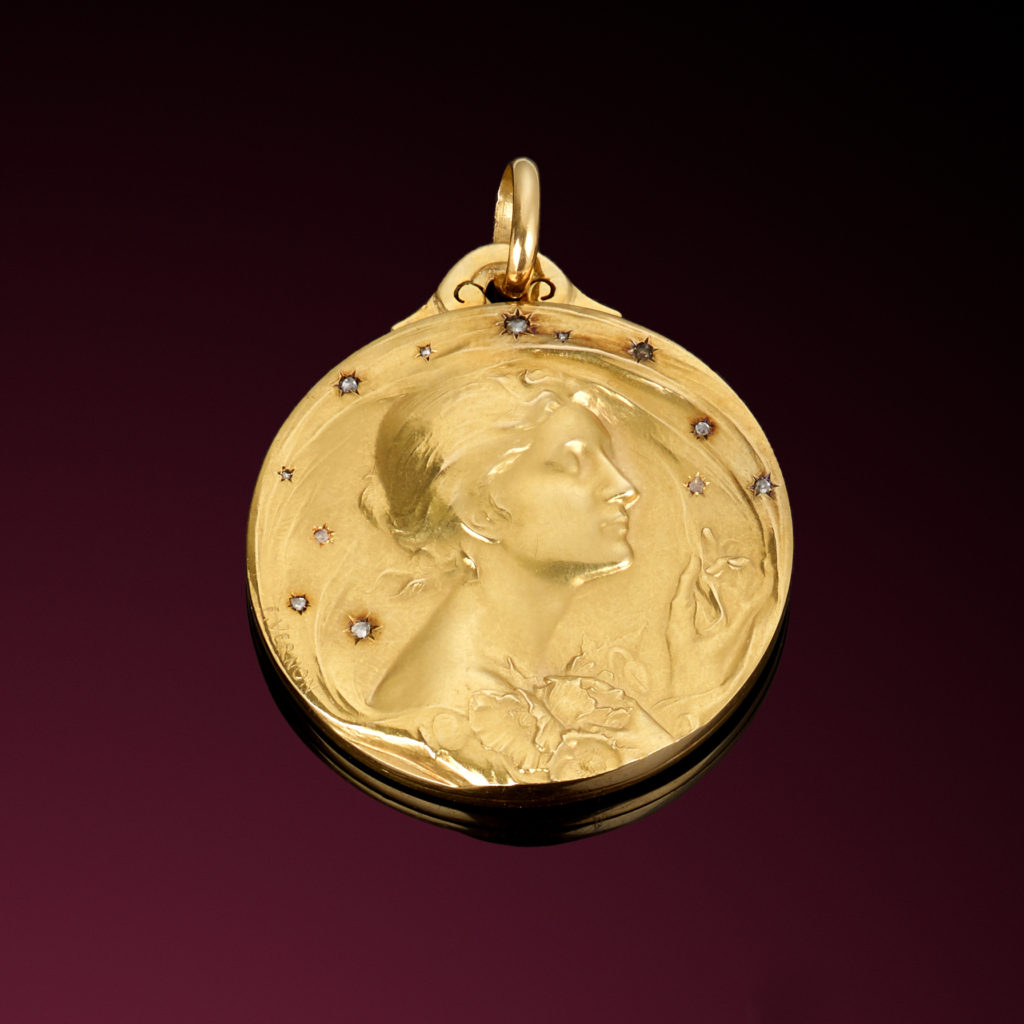Frédéric Charles Victor de Vernon was born in 1858 in Paris where he spent most of his life until his death in 1912.
Frédéric Charles Victor de Vernon
As a teenager, de Vernon learnt die engraving at the workshop of celebrated engraver Ernest Paulin Tasset. Tasset made medals and commemorative coins for the Paris mint and for many other countries’ currencies. De Vernon’s skills were recognised and he progressed to the prestigious École des beaux-arts in 1879, when he was 21. He was taught by sculptor Pierre-Jules Cavelier, who also taught British sculptor Sir Alfred Gilbert RA, and by medallist Jules-Clément Chaplain. With guidance from a sculptor and a medallist, it was perhaps unsurprising that de Vernon embraced both forms in his work: creating small sculptures to be made into medals.
A talented sculptor, engraver, and medallist, de Vernon exhibited every year at the Parisian Salons, grand exhibitions of artists’ new work, where he started garnering more acclaim. In 1887, he won the premier Prix de Rome for his medal depicting ‘Jason Conquering the Golden Fleece’. The prize was a scholarship from the French government to live and work in Rome. As a result, de Vernon spent three years at the French Academy in Rome, the Villa Medici.
de Vernon's work with Duval
De Vernon’s return to Paris marked the beginning of his prolific period of medal making. Jeweller Julien Duval, a peer from the École des Arts Décoratifs, came to him with a proposition. He suggested that de Vernon designed medals could be used in both the traditional medallist style and in lighter medal-inspired jewellery. Influenced by ancient coins and medallions, these medal-jewels were a popular choice during the archaeological revival trend. This was in the mid-nineteenth century. Jewellers continued to turn to the medal as the beginnings of the Art Nouveau movement. A principal tenet of Art Nouveau amongst its early pioneers in Belgium and France, was to break down the divide between fine and applied arts. This as well as William Morris’s Arts and Crafts movement in Britain. Medallists’ work sculpting and engraving small works of art for medals thus put them right at the centre of the Art Nouveau movement, its principles and practitioners.
Duval's specialties...
Julien Duval specialised in editions of artists’ and sculptors’ medals. With de Vernon, the pair worked together on a successful series of models from 1896. De Vernon would begin by designing the motif, then sculpting and engraving a die to reproduce the design. Then Duval’s workshop took over the process of making multiple copies of the design in bronze, silver or gold. Together, de Vernon and Duval, created a series of medals with motifs of women representing dawn, day and night. Though the medal in February’s auction is only marked ‘F. Vernon’, some other examples of ‘La Nuit’ include Duval’s stamp. It is therefore likely that lot 381 is indeed from their collaboration. The pair also made several designs of the Virgin Mary, or Madonna, with a halo or a stained-glass window of plique-à-jour or cloisonné enamel. One such example is now in the collection of the British Museum. They also made designs of the ‘Femme-Fleurs’ motif of flowers surrounding a woman’s head.
de Vernon's legacy
De Vernon is now known both for his jewellery designs and his medals. He worked on commissions for medals to commemorate the spercial events. This including birthdays of scientists, anniversaries of international congresses, the opening of a water source at Evian Spa, prizes for horticultural competitions, and the official medals of the 1900 Summer Olympics in Paris. His medals are now held in the collections of the Metropolitan Museum of Art, New York. This as well as London, the British Museum, the Science Museum and the Victoria & Albert Museum.
La Nuit by de Vernon
Let's look at the Art Nouveau gold ‘The Night’ pendant, with rose-cut diamond ‘star’ highlights, by Frédéric Charles Victor de Vernon. We sold this piece for a total price realised of £1,300 in our Fine Jewellery auction on Thursday 9th February 2023.

This pendant is a delicate example of de Vernon’s prowess as a sculptor. Such skills earned him great accolades and numerous commissions in Europe at the turn of the twentieth century. Many of his medals and jewels are in museum collections around the world. Therefore, the pendant in this sale offers a rare chance to own a small piece of Art Nouveau history.
This design is ‘La Nuit’ – ‘The Night’. The gold pendant features a woman, representing the embodiment of the night. She is in profile, her eyes closed and one hand raised. Her other hand is clutching a corsage of poppies. Around her light, tied-up curls, twinkle stars set with rose-cut diamonds.

What did the poppies used to symbolise...
Though poppies later became associated with remembrance after the First World War. Earlier language of flowers poppies symbolised deep sleep. It is likely this meaning that de Vernon referenced in his design for ‘La Nuit’. The flowers and the swirling sky of this pendant show a distinct leaning towards Art Nouveau styles and motifs. They were typically naturalistic and sinuous, at a time when the movement was gaining momentum across Europe.
The British Museum holds a brooch by de Vernon with a medallion featuring a female head in profile. It has small diamonds at her neck and around her hair, reminiscent of the style of The Night.
The delicacy of de Vernon’s depiction of the night stemmed from his training in engraving and sculpture.
A similar ‘La Nuit’ pendant is illustrated in Vivienne Becker’s Art Nouveau Jewelry (1985), plate 147.












